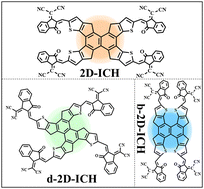Isomerization of two-dimensional non-fullerene electron acceptor materials for developing high-performance organic solar cells†
Abstract
Although the power conversion efficiency of organic solar cells has recently exceeded 19% benefiting from the development of non-fullerene acceptors (NFAs), the electron affinity and electron mobility of NFAs still lag behind those of fullerene acceptors. Therefore, it is necessary to investigate a design rule that can break the currently used A–D–A linear strategy. In our early study, we have proposed a kind of two-dimensional (2D) NFA containing four electron-withdrawing end groups, which exhibited better electron affinity and electron mobility than those of typical linear NFAs. As we know, isomerism is one of the major factors affecting the properties of materials. Herein, three isomeric 2D NFAs based on a 2D fused-ring core (naphthalene) and four electron-withdrawing end groups, 2D-ICH, d-2D-ICH and b-2D-ICH, are reported, which exhibited a similar chemical structure but different symmetries. The molecular structures, intramolecular interactions, energy level, electron affinity, electrostatic potential, absorption spectra, exciton binding energy, electron mobility, solubility and chemical stability of these isomers were investigated. The results indicated that the isomerism of the conjugated backbone is an efficient method to turn the optoelectronic properties of NFA materials. d-2D-ICH shows an appropriate LUMO energy of –3.99 eV, a high electron affinity of 3.34 eV, higher integrated absorption intensity and smaller exciton binding energy than those of Y6, good solubility of 52 mg mL−1 in chlorobenzene, the highest chemical stability, and high electron mobility of 9.42 × 10−4 cm2 V−1 s−1. This demonstrated that numerous critical factors including absorption intensity, exciton separation, chemical stability, and charge mobility of d-2D-ICH are superior to those of widely used Y6. We propose that d-2D-ICH will be an excellent candidate for the development of next-generation NFAs for high-performance organic solar cells.

- This article is part of the themed collection: Stability of Optoelectronic Materials and Devices


 Please wait while we load your content...
Please wait while we load your content...